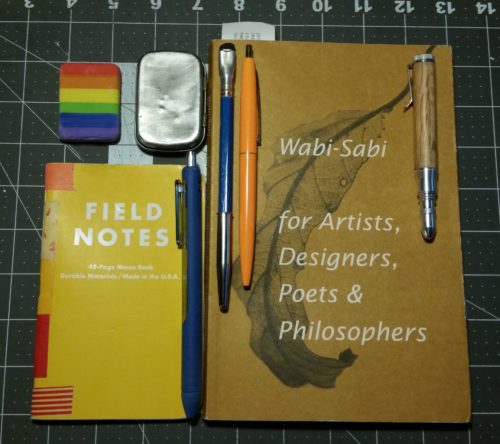Wabi-sabi is a confusing concept, especially for us Americans who tend to strive for more and better and more. This isn’t to suggest that we shouldn’t strive for better or what we need, but part of the concept of wabi-sabi is acceptance for what we have. Further it is in part accepting that nothing is perfect, that life is impermanent, and that there is beauty in not only the cracks but the differences. This is where I think wabi-sabi deserves a place in every art journaler’s list of things to read.
I’ve noticed an uptick in people posting really polished pages out of their art journal to AJNing, the original as well as other places on the internet. In fact I’d say YouTube is rife with beautiful polished pages. What I’ve always found interesting about art journaling, and journaling* in general, is that the journal is a tool, and the most interesting journals I’ve seen are those that involve the struggle and document the work. This struggle is where the concept of wabi-sabi overlaps with journaling and where I think many journalers need to consider accepting their pages and journals as they work on them.
Acceptance seems to be a large part of wabi-sabi, it’s also a key component of mindfulness. Wabi-Sabi takes that acceptance a step further and not only do you seek to accept things in their imperfection, but you strive to see the beauty inherent in their imperfection and unique individuality. This is the part of wabi-sabi that is most important to a journaling practice, being able to accept the imperfection that you have created on the page, and allowing yourself to see that this is a reflection of the self.
Anyway, I chose to look a little more closely at this book because like next week’s SSS, Writing as a Way of Healing, it deeply speaks to my journaling practice and has influenced my thinking of acceptance of both myself and my art.
*I’m simply going to call art journaling, journaling for the remainder of this post. I’m discussing both AJ and regular journaling but I think there is less of a divide in the use of the journal as a tool than many of us think or thought. Both are visual and both use words, perhaps in different manners, but both are journals.
Yes, all links in this post are Amazon Affiliate links. I get a few pieces of coin should you chose to purchase the book through these links. No it is not a lot of coins. Every penny helps to buy more books, art supplies, and yes to keep this blog up and running.